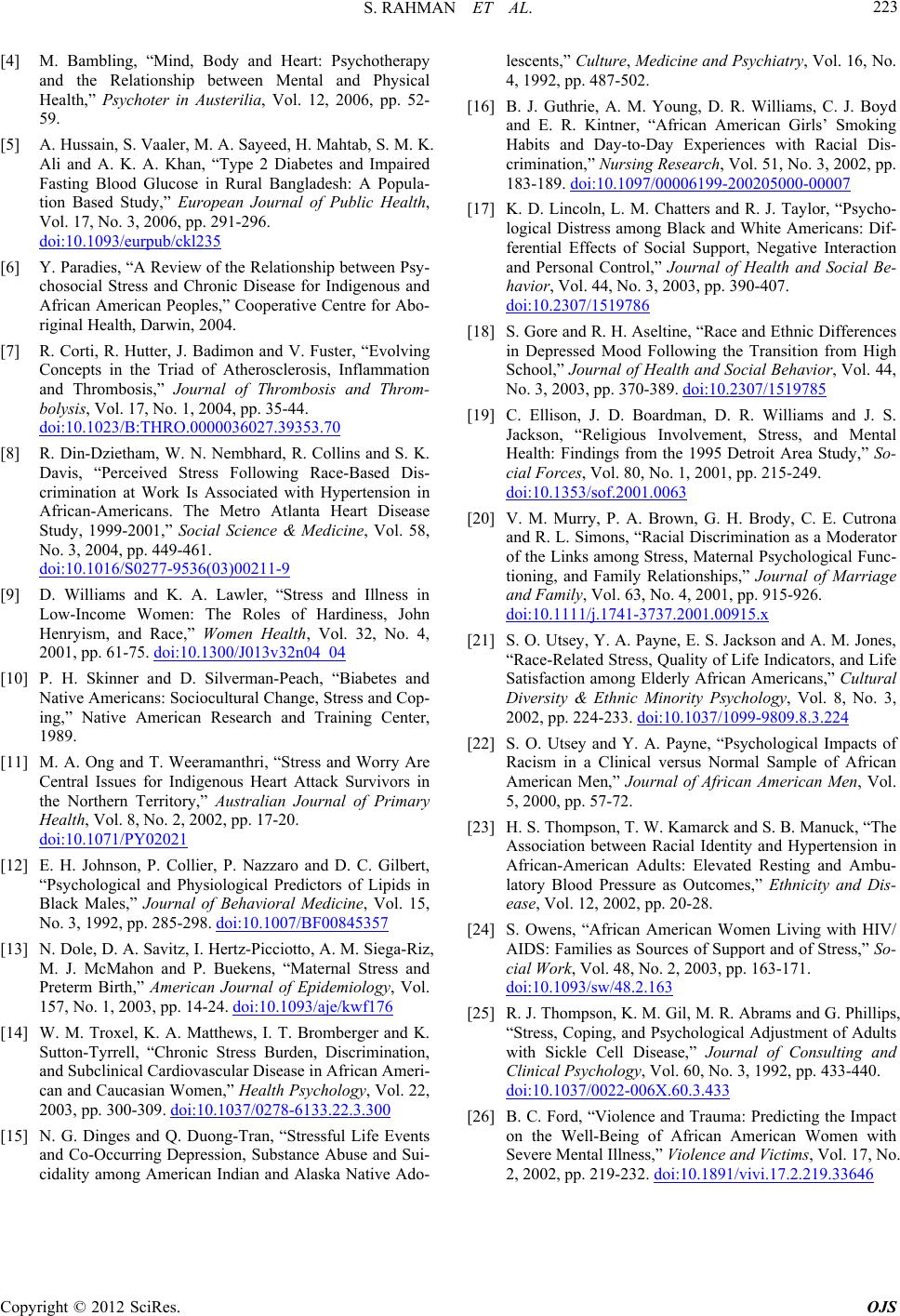
S. RAHMAN ET AL. 223
[4] M. Bambling, “Mind, Body and Heart: Psychotherapy
and the Relationship between Mental and Physical
Health,” Psychoter in Austerilia, Vol. 12, 2006, pp. 52-
59.
[5] A. Hussain, S. Vaaler, M. A. Sayeed, H. Mahtab, S. M. K.
Ali and A. K. A. Khan, “Type 2 Diabetes and Impaired
Fasting Blood Glucose in Rural Bangladesh: A Popula-
tion Based Study,” European Journal of Public Health,
Vol. 17, No. 3, 2006, pp. 291-296.
doi:10.1093/eurpub/ckl235
[6] Y. Paradies, “A Review of the Relationship between Psy-
chosocial Stress and Chronic Disease for Indigenous and
African American Peoples,” Cooperative Centre for Abo-
riginal Health, Darwin, 2004.
[7] R. Corti, R. Hutter, J. Badimon and V. Fuster, “Evolving
Concepts in the Triad of Atherosclerosis, Inflammation
and Thrombosis,” Journal of Thrombosis and Throm-
bolysis, Vol. 17, No. 1, 2004, pp. 35-44.
doi:10.1023/B:THRO.0000036027.39353.70
[8] R. Din-Dzietham, W. N. Nembhard, R. Collins and S. K.
Davis, “Perceived Stress Following Race-Based Dis-
crimination at Work Is Associated with Hypertension in
African-Americans. The Metro Atlanta Heart Disease
Study, 1999-2001,” Social Science & Medicine, Vol. 58,
No. 3, 2004, pp. 449-461.
doi:10.1016/S0277-9536(03)00211-9
[9] D. Williams and K. A. Lawler, “Stress and Illness in
Low-Income Women: The Roles of Hardiness, John
Henryism, and Race,” Women Health, Vol. 32, No. 4,
2001, pp. 61-75. doi:10.1300/J013v32n04_04
[10] P. H. Skinner and D. Silverman-Peach, “Biabetes and
Native Americans: Sociocultural Change, Stress and Cop-
ing,” Native American Research and Training Center,
1989.
[11] M. A. Ong and T. Weeramanthri, “Stress and Worry Are
Central Issues for Indigenous Heart Attack Survivors in
the Northern Territory,” Australian Journal of Primary
Health, Vol. 8, No. 2, 2002, pp. 17-20.
doi:10.1071/PY02021
[12] E. H. Johnson, P. Collier, P. Nazzaro and D. C. Gilbert,
“Psychological and Physiological Predictors of Lipids in
Black Males,” Journal of Behavioral Medicine, Vol. 15,
No. 3, 1992, pp. 285-298. doi:10.1007/BF00845357
[13] N. Dole, D. A. Savitz, I. Hertz-Picciotto, A. M. Siega-Riz,
M. J. McMahon and P. Buekens, “Maternal Stress and
Preterm Birth,” American Journal of Epidemiology, Vol.
157, No. 1, 2003, pp. 14-24. doi:10.1093/aje/kwf176
[14] W. M. Troxel, K. A. Matthews, I. T. Bromberger and K.
Sutton-Tyrrell, “Chronic Stress Burden, Discrimination,
and Subclinical Cardiovascular Disease in African Ameri-
can and Caucasian Women,” Health Psychology, Vol. 22,
2003, pp. 300-309. doi:10.1037/0278-6133.22.3.300
[15] N. G. Dinges and Q. Duong-Tran, “Stressful Life Events
and Co-Occurring Depression, Substance Abuse and Sui-
cidality among American Indian and Alaska Native Ado-
lescents,” Culture, Medicine and Psychiatry, Vol. 16, No.
4, 1992, pp. 487-502.
[16] B. J. Guthrie, A. M. Young, D. R. Williams, C. J. Boyd
and E. R. Kintner, “African American Girls’ Smoking
Habits and Day-to-Day Experiences with Racial Dis-
crimination,” Nursing Research, Vol. 51, No. 3, 2002, pp.
183-189. doi:10.1097/00006199-200205000-00007
[17] K. D. Lincoln, L. M. Chatters and R. J. Taylor, “Psycho-
logical Distress among Black and White Americans: Dif-
ferential Effects of Social Support, Negative Interaction
and Personal Control,” Journal of Health and Social Be-
havior, Vol. 44, No. 3, 2003, pp. 390-407.
doi:10.2307/1519786
[18] S. Gore and R. H. Aseltine, “Race and Ethnic Differences
in Depressed Mood Following the Transition from High
School,” Journal of Health and Social Behavior, Vol. 44,
No. 3, 2003, pp. 370-389. doi:10.2307/1519785
[19] C. Ellison, J. D. Boardman, D. R. Williams and J. S.
Jackson, “Religious Involvement, Stress, and Mental
Health: Findings from the 1995 Detroit Area Study,” So-
cial Forces, Vol. 80, No. 1, 2001, pp. 215-249.
doi:10.1353/sof.2001.0063
[20] V. M. Murry, P. A. Brown, G. H. Brody, C. E. Cutrona
and R. L. Simons, “Racial Discrimination as a Moderator
of the Links among Stress, Maternal Psychological Func-
tioning, and Family Relationships,” Journal of Marriage
and Family, Vol. 63, No. 4, 2001, pp. 915-926.
doi:10.1111/j.1741-3737.2001.00915.x
[21] S. O. Utsey, Y. A. Payne, E. S. Jackson and A. M. Jones,
“Race-Related Stress, Quality of Life Indicators, and Life
Satisfaction among Elderly African Americans,” Cultural
Diversity & Ethnic Minority Psychology, Vol. 8, No. 3,
2002, pp. 224-233. doi:10.1037/1099-9809.8.3.224
[22] S. O. Utsey and Y. A. Payne, “Psychological Impacts of
Racism in a Clinical versus Normal Sample of African
American Men,” Journal of African American Men, Vol.
5, 2000, pp. 57-72.
[23] H. S. Thompson, T. W. Kamarck and S. B. Manuck, “The
Association between Racial Identity and Hypertension in
African-American Adults: Elevated Resting and Ambu-
latory Blood Pressure as Outcomes,” Ethnicity and Dis-
ease, Vol. 12, 2002, pp. 20-28.
[24] S. Owens, “African American Women Living with HIV/
AIDS: Families as Sources of Support and of Stress,” So-
cial Work, Vol. 48, No. 2, 2003, pp. 163-171.
doi:10.1093/sw/48.2.163
[25] R. J. Thompson, K. M. Gil, M. R. Abrams and G. Phillips,
“Stress, Coping, and Psychological Adjustment of Adults
with Sickle Cell Disease,” Journal of Consulting and
Clinical Psychology, Vol. 60, No. 3, 1992, pp. 433-440.
doi:10.1037/0022-006X.60.3.433
[26] B. C. Ford, “Violence and Trauma: Predicting the Impact
on the Well-Being of African American Women with
Severe Mental Illness,” Violence and Victims, Vol. 17, No.
2, 2002, pp. 219-232. doi:10.1891/vivi.17.2.219.33646
Copyright © 2012 SciRes. OJS